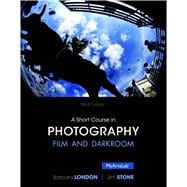Explores the fundamentals of photography
A Short Course in Photography: Film and Darkroom, 9/e introduces students to the fundamentals of photography and suggests ways in which they might create photographs that have meaning. With a special focus on black and white photography, the book also explores digital techniques and web photography resources, equipment, cameras and camera accessories, the exposure and development of film, and the making and finishing of prints. All aspects of the process are explained and clearly illustrated for students to access. Every pair of pages covers a complete topic along with the accompanying illustrations, diagrams, and photos. Students will be exposed to photographs by some of the greatest artists, including Deborah Willis, Roe Ethridge, Gordon Parks, Rebecca Cummins, Javier Manzano, and Gueorgui Pinkhassov.
MyArtsLab is an integral part of the London / Stone program. Engaging activities and assessment are part of a teaching and learning system that helps students gain a broader understanding of photography. With MyArtsLab, students can explore in-depth analyses of relevant artwork, architecture, artistic techniques, and more.
0133810356 / 9780133810356 A Short Course in Photography Plus NEW MyArtsLab with Pearson eText -- Access Card Package
Package consists of:
0205206565 / 9780205206568 NEW MyArtsLab with Pearson eText -- Valuepack Access Card
0205982433 / 9780205982431 Short Course in Photography, A
ALERT: Before you purchase, check with your instructor or review your course syllabus to ensure that you select the correct ISBN. Several versions of Pearson's MyLab & Mastering products exist for each title, including customized versions for individual schools, and registrations are not transferable. In addition, you may need a CourseID, provided by your instructor, to register for and use Pearson's MyLab & Mastering products.
Packages
Access codes for Pearson's MyLab & Mastering products may not be included when purchasing or renting from companies other than Pearson; check with the seller before completing your purchase.
Used or rental books
If you rent or purchase a used book with an access code, the access code may have been redeemed previously and you may have to purchase a new access code.
Access codes
Access codes that are purchased from sellers other than Pearson carry a higher risk of being either the wrong ISBN or a previously redeemed code. Check with the seller prior to purchase.
--








